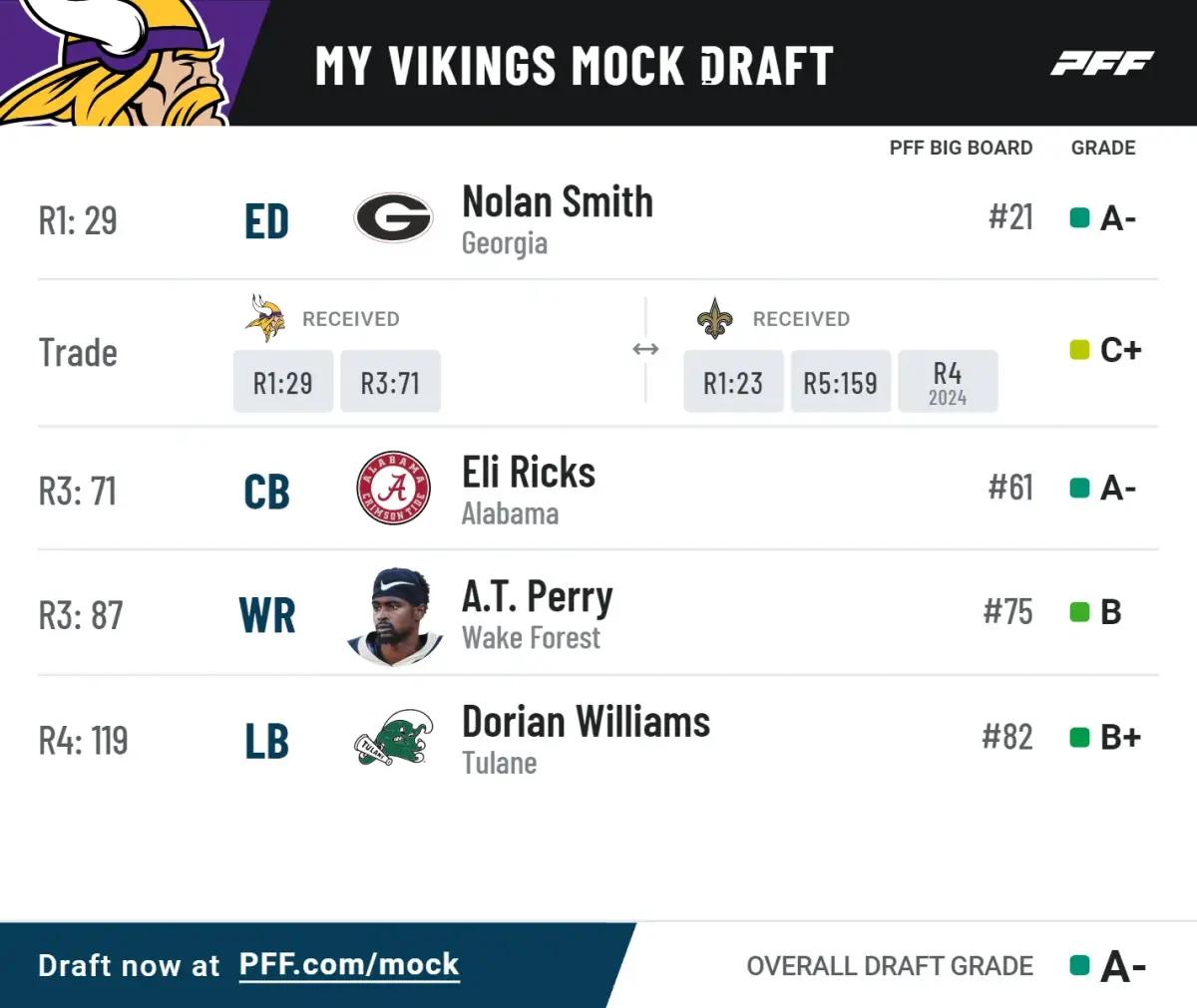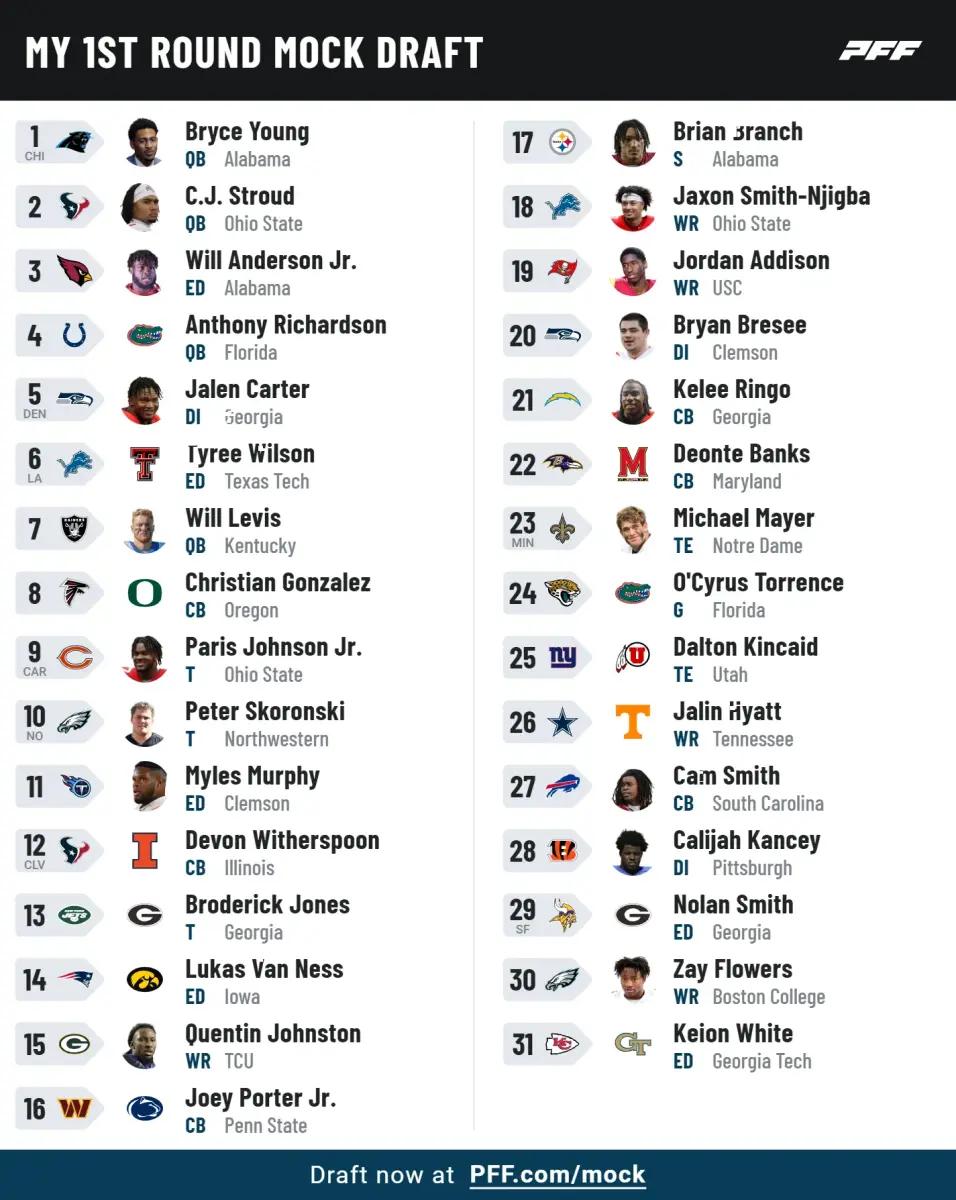A post-free agency first wave Vikings draft simulation

When free agency week arrived, it appeared the Minnesota Vikings might soon look like a wildly different team than they did during their 13-win 2022 season. Now that the dust has settled on one of the NFL’s most eventful seven-day stretches, the Vikings are definitely different but they haven’t torn the roster down to the screws or gone crazy adding new parts. Of course, there are still things yet to be determined, like whether they will move on from Za’Darius Smith and/or Dalvin Cook and what the future holds for the quarterback position after Kirk Cousins’s contract was restructured but we can draw a much more accurate picture of the Vikings’ draft needs than prior to the start of the new league year.
So let’s run another draft simulation using the PFF Mock Draft tool and go through some of the potential scenarios they could encounter come draft night…
The sim
On the Purple Insider podcast, PFF draft analyst Mike Renner said that he only looked at around 25-30 players as true first-round prospects, meaning that if the Vikings trade down they should avoid dropping back too far. With that in mind, GM Purple Insider elected to move back with a team that traditionally loves trading up: The New Orleans Saints. We sent the 23rd, 159th and a 2024 fourth-round pick to the Saints in exchange for the 29th and 71st pick this year. Getting another top-100 pick gives the Vikings a chance to fill another need without giving up too much ground or future capital.
Here’s how the picks played out after the trade:

About the No. 29 pick
There is uncertainty around the edge rusher position with the Vikings signing Marcus Davenport to a one-year deal and questions about the futures of Za’Darius Smith and Danielle Hunter so it makes sense to target a pass rusher with high upside and some developmental needs. Nolan Smith is undersized at 6-foot-2, 238 pounds but fits the bill of a 3-4 outside linebacker for new defensive coordinator Brian Flores. At the NFL Combine, he put together one of the most impressive performances of any edge rusher ever with a 4.39 40-yard dash and 41 inch broad jump. While production at Georgia was only so-so with 12.5 sacks in four years, he still graded over 80 by PFF in back-to-back years for the Bulldogs.
From the PFF draft guide: “Smith is unique in so many ways with a lot of projectable NFL traits. He'll likely be a more productive pass-rusher in the NFL than he was at Georgia.”
Who else was available
Had we stayed at the 23rd pick, there would have been some very enticing options, most notably blazing fast receiver Jalin Hyatt, South Carolina cornerback Cam Smith and Pitt defensive tackle Calijah Kancey.
Here’s the best players aside from Smith who were still on the board with the 29th pick:
- WR, Zay Flowers, Boston College
- ED, Keion White, Georgia Tech
- CB, Emmanuel Forbes, Mississippi State
- RB, Bijan Robinson, Texas
- ED, Will McDonald, Iowa State
- DI, Mazi Smith, Michigan
The most difficult player to pass up on the list was Flowers, who gained over 1,000 yards receiving and ran an impressive 4.4 40-yard dash at the Combine. After letting Adam Thielen go, the Vikings are in need of another option at receiver but the gap between some receivers projected in the late first and in the second/third rounds isn’t as vast as past years so GM PI elected to wait.
About the other picks
CB, Eli Ricks, Alabama
The 6-foot-2 defensive back allowed only nine completions on 34 targets in press coverage, which would seem to match up nicely with Flores’s scheme. He may have been considered a much higher rated prospect with more experience but injuries limited him to only 15 games in the last two years.
WR, AT Perry, Wake Forest
A 6-foot-4 receiver, Perry produced back-to-back 1,000 yard receiving seasons and double-digit touchdowns for the Demon Deacons. Expectations for Perry in the draft have varied since but his 4.4 40-yard dash at the Combine helped his case as a taller receiver. The downside to his game is that Perry worked solely as an outside receiver in college and did not have impressive contested catch numbers (44%) for a receiver of his size. Still PFF graded him a 78.5 vs. man coverage, which may bode well for him when opponents try to press.
LB, Dorian Williams, Tulane
The Vikings clearly aren’t afraid of undersized linebackers so the 6-foot-1, 228-pounder could be an intriguing prospect. He was one of the highest graded coverage linebackers in the country by PFF and ran a lightning quick 4.5 40-yard dash.
“Williams has an interesting coverage skill set with the kind of length that defensive coordinators can work with,” PFF wrote.
With Jordan Hicks reworking his contract to stay alongside Brian Asamoah, the Vikings could develop a player like Williams with plans to have him start in 2024 in the best-case scenario.
How the rest of the first round played out
With Kirk Cousins’s restructure setting up a possible end date to his time in Minnesota, keeping an eye on the quarterbacks in the draft should be a priority but in this simulation there wasn’t a great opportunity to move up as the fourth QB picked Will Levis was gone by the No. 7 overall selection.
Also relevant was the placement of receivers and corners, both of which flew off the board just before the Vikings’ selection. Seven CB or WRs were picked before the 23rd pick, making it an easier decision to trade down. Here’s a look at the entire first round:

The bottom line
Not that much has changed for the Vikings since free agency in terms of their potential needs except for moving the linebacker and receiver positions up the board of needs. Trading down isn’t a sexy option but if the Vikings can add pieces for their defensive rebuild and a potential offensive weapon who could contribute right away that would appear to be a win considering they’re so short on draft capital.
